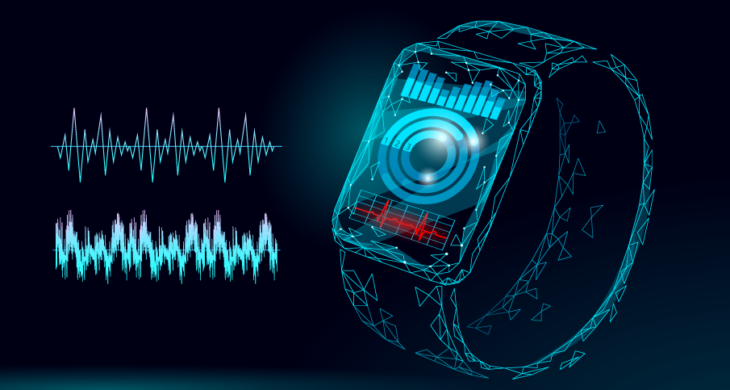
Date: 8th February 2021
Parkinson’s Disease (PD) is a long-term degenerative disorder of the central nervous system that mainly affects the motor system. Early symptoms include tremors, rigidity, slowness of movement and difficulty with walking. Monitoring of motor symptoms in PD could enable more precise treatment decisions and could also be used to evaluate effectiveness of treatments. Now, researchers have developed the Motor fluctuations Monitor for Parkinson’s Disease (MM4PD), a monitoring system that uses smartwatch sensors to continuously track fluctuations in resting tremors and other involuntary movements.
More than 10 million people worldwide are living with PD, and a clinician’s ability to precisely prescribe and adjust medications is core to the quality of life of PD patients, but remains a challenge. Typically specialists rely on a patient’s recall of symptoms, and a snapshot during their visits, meaning that often subtle disease progression or daily fluctuations are missed. An added complications is that dyskinesia often occurs in PD patients, which are medication-induced involuntary and erratic movements and that are not symptoms of PD itself.
Now, researchers at Apple Inc., led by Adeeti Ullal, in collaboration with PD specialists have developed a smartwatch-based system that could track dyskinesia and resting tremors in PD patients, called MM4PD. The system could identify changes in symptoms as a result of medication changes or deep brain stimulation treatment, could detect patients who had missed medication, and recognised participants who could benefit from a modified medication regime.
The researchers developed MM4PD in two main phases, the first designing an algorithm that converted the raw inertial sensor data from the accelerometer and gyroscope of an Apple smartwatch into tremor and dyskinesia estimates. The second, involved the validation of MM4PD’s output ability to capture fluctuations in daily symptom profiles in response to medication and other factors whilst the subject was engaged in real-world day-to-day situations.
The MM4PD was then evaluated in 343 participants with PD, of which 61 had dyskinesia, including a longitudinal study of up to 6 months in a 225-subject cohort, it was also tested in 171 elderly, non-PD controls.
The team found that the system could capture symptom patterns relevant in the course of disease and treatment monitoring. For example it could capture profiles changes after individuals underwent surgery for deep brain stimulation (DBS) and after DBS reprogramming. It was able to determine when a subject became more adherent to their prescribed treatment plan, and identify days with worsened symptoms and the subsequent improvement with an additional dose of medication. MM4PD could also identify unexpected responses to treatment that may not be caught by traditional clinical assessment.
A clinician reviewed the smartwatch symptom profiles of 112 subjects in the longitudinal patient study who underwent treatment changes. Here, 94% of the patients’ symptom profiles matched that of the expert. However, in the remained of the cohort, the smartwatch profiles identified imperceptible (by traditional methods) symptoms changes, that aided the clinician into improving the pharmacologic strategy for these patients.
Conclusions and future applications
The data presented here demonstrates the potential of smartwatch-based remote monitoring for PD, and supports the further investigation of MM4PD as a tool to support patient-clinician communication, medication titration, and clinical trial design.
It is hoped that the familiarity, ease of use and availability of smartwatches, such as here with the Apple watch, will allow those patients that are vulnerable, have difficulty in attending hospital appointments, or those that have trouble with memory, a better way to monitor and track symptoms, aiding clinicians with a continuous data that will improve clinical and medication decisions.
Indeed, there is a growing demand for smartwatches and smartphones to monitor and diagnoses an increasing range of conditions. The Apple watch has also be used to detect atrial fibrillation, which is often intermittent in appearance, meaning that symptoms can be mild or absent, making detection and diagnosis difficult and leading to the condition often going undiagnosed. Smartphone apps can be used detect skin cancer via the use of the inbuilt camera. Such mobile devices address common barriers users face in remote care setting, place control back into the hands of user, and offering accessibility that is hard to obtain in a clinical setting.
In the future, this technology has the potential to serve a wide range of applications such as to quantify post-operative improvements, progress treatments plans, or to motivate patients to remain adherent. The ability for clinicians and researcher to access out-of-clinic data will accelerate treatments for PD, and ultimately improve patient care and outcomes.
Powers, R., M. Etezadi-Amoli, E. M. Arnold, S. Kianian, I. Mance, M. Gibiansky, D. Trietsch, A. S. Alvarado, J. D. Kretlow, T. M. Herrington, S. Brillman, N. Huang, P. T. Lin, H. A. Pham and A. V. Ullal (2021). “Smartwatch inertial sensors continuously monitor real-world motor fluctuations in Parkinson’s disease.” Science Translational Medicine 13(579): eabd7865.
https://doi.org/10.1126/scitranslmed.abd7865
